Colonial houses can be tricky territory. Done wrong, they end up looking like Disney movie sets or those suburban developments where every house is basically the same beige box with some columns slapped on the front. But when you nail the colonial aesthetic, you get this incredible combination of formal elegance and lived-in comfort that never goes out of style.
The secret isn’t copying museum houses or trying to recreate 1750 exactly. It’s about understanding what made colonial architecture so appealing in the first place—the proportions, the materials, the way everything feels substantial and rooted—then adapting those principles for how we actually want to live today.
Really great colonial exteriors feel both timeless and completely current, like they’ve been there forever but also work perfectly for modern families with cars, outdoor kitchens, and home offices.
What Makes Colonial Design Actually Work Today
Colonial architecture has lasted centuries because it’s based on principles that create genuinely comfortable, beautiful living rather than just following stylistic rules.
Symmetry Creates Instant Elegance – Those balanced facades and centered doorways aren’t just pretty—they create visual calm and a sense of order that makes homes feel more substantial and welcoming.
Quality Materials Age Beautifully – Real brick, natural stone, solid wood shutters, and slate roofs get better with time instead of showing wear badly like synthetic alternatives.
Proportions Matter More Than Decorative Details – The most successful colonial updates focus on getting window sizes, door placement, and roof lines right rather than adding fussy historical details.
Indoor-Outdoor Connection Enhances Livability – Modern colonial designs work because they create seamless flow between interior spaces and outdoor living areas that families actually use.
Updating Colonial Style for Real Life
The trick is keeping what works about colonial design while adapting it for contemporary needs and technologies.
Respect the Bones, Update the Systems – Work with classical proportions and materials while integrating modern heating, cooling, lighting, and technology invisibly.
Choose Additions That Feel Intentional – New wings, decks, and garages should feel like they’ve always belonged rather than obvious afterthoughts.
Mix Traditional and Contemporary Materials Thoughtfully – Steel windows, glass railings, and modern lighting can work beautifully with brick and stone when the proportions stay consistent.
Plan Landscapes That Enhance Architecture – Formal gardens, structured plantings, and quality hardscaping make colonial houses feel more substantial and rooted in place.
Colonial Exterior Ideas That Actually Work
Traditional Brick with Modern Glass Extension
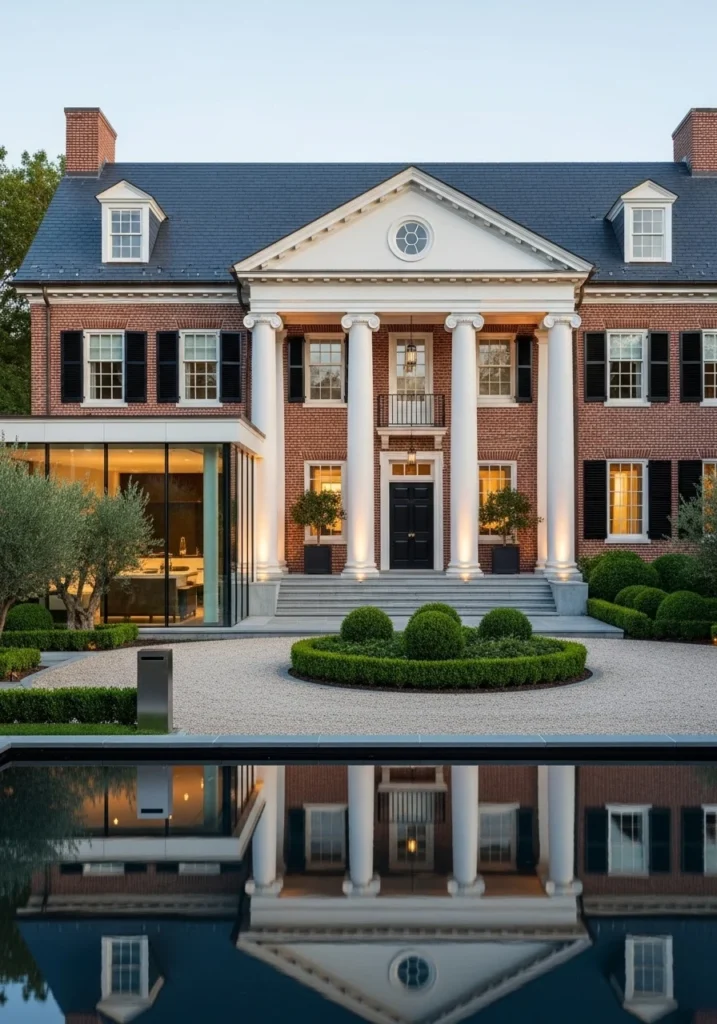
Combine classic red-brick colonial with central portico and white columns with a contemporary glass-walled addition that reflects a formal water feature.
The contrast between traditional masonry and modern transparency creates visual interest while the reflecting pool ties everything together. Add recessed uplighting and sculptural plantings for evening drama.
This approach works when you need more space but want additions to feel like thoughtful architectural choices rather than obvious expansions.
Updated Clapboard with Steel Window Frames
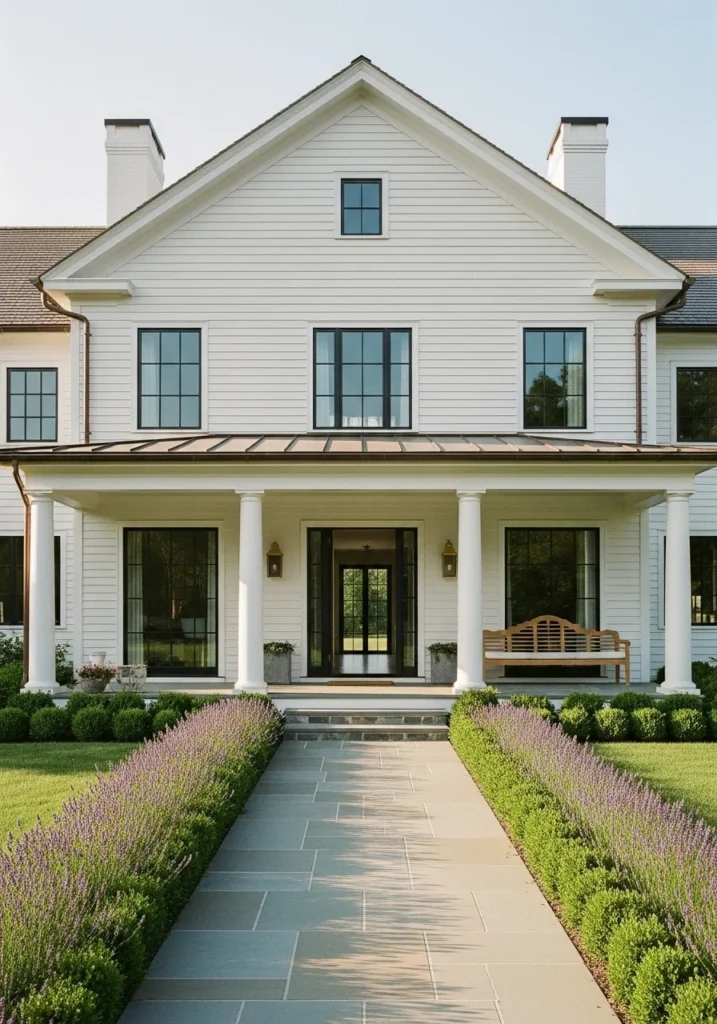
Take traditional white clapboard siding and elevate it with contemporary black steel-framed windows that have better proportions and cleaner lines than typical vinyl replacements.
Add warm brass lanterns and natural stone walkways with structured hedge plantings. The steel frames provide crisp contrast while maintaining colonial character.
Perfect for people who love colonial charm but want their house to feel current rather than like a historical recreation.
Limestone Georgian Manor Sophistication
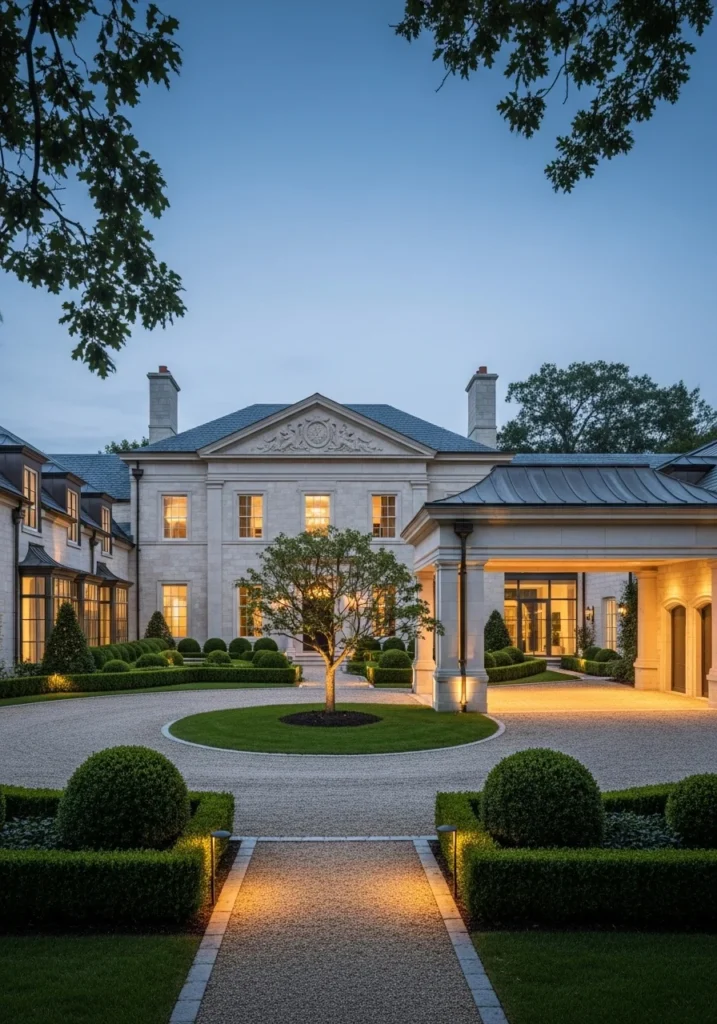
Create substantial presence with Georgian-inspired limestone construction, symmetrical windows, and elegant porte-cochere for sheltered arrival.
Include formal parterres and circular gravel drives with mature trees. The limestone provides luxury materials while classical proportions create timeless elegance.
This approach works for larger properties where formal grandeur fits the site and lifestyle.
Coastal Colonial with Contemporary Pool Integration

Adapt colonial principles for coastal living with pale shiplap siding, wide porches, and sleek glass-railed deck leading to minimalist lap pool.
Use hurricane-rated shutters and coastal plantings that handle salt air while maintaining structured appearance. The pool integration feels natural rather than added-on.
Great for coastal properties where outdoor living and weather protection are priorities.
Symmetrical Design with Green Roof Garage

Design grand symmetrical colonial with multiple dormers and separate garage featuring living green roof that provides environmental benefits while looking intentional.
Wide bluestone paths and formal hedging maintain classical formality while the green roof shows contemporary environmental consciousness.
This works when you want traditional elegance but also care about sustainability and stormwater management.
Also Read: How to Create a Farmhouse Living Room That Actually Feels Chic
Minimalist Colonial in Monochrome
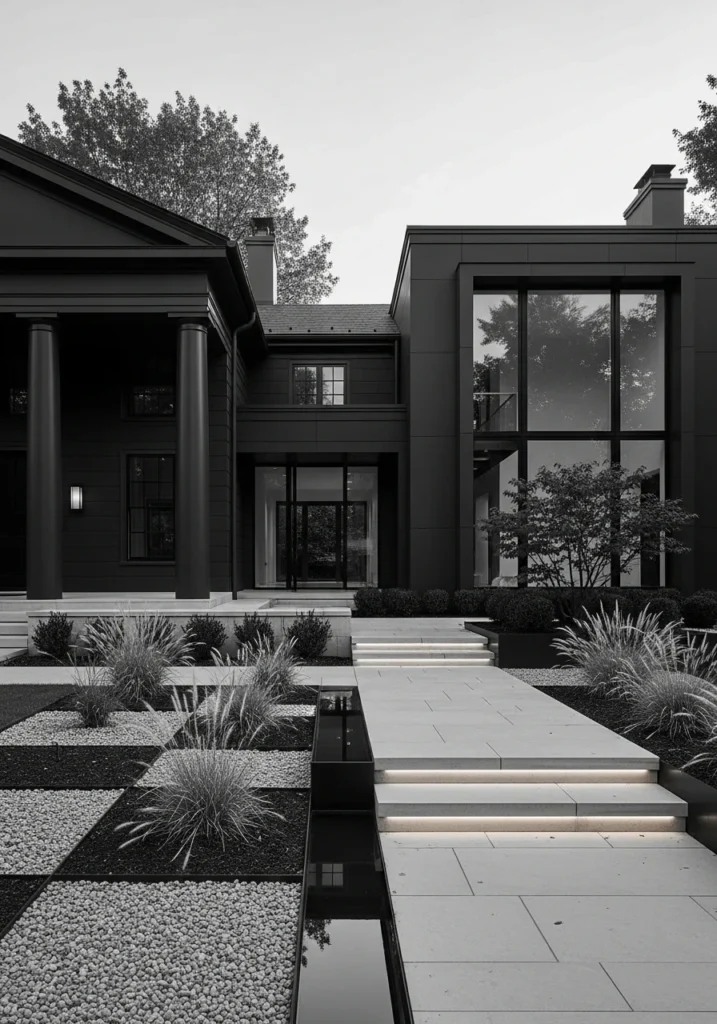
Create sophisticated restraint with deep charcoal paint, matte black trim, and simple classical portico combined with frameless glazing on one wing.
Use structured gravel plantings and reflecting water channel for modern landscape elements that complement rather than compete with architecture.
Perfect for people who appreciate colonial proportions but want minimal, contemporary aesthetic rather than busy historical details.
Farmhouse Hybrid with Reclaimed Materials
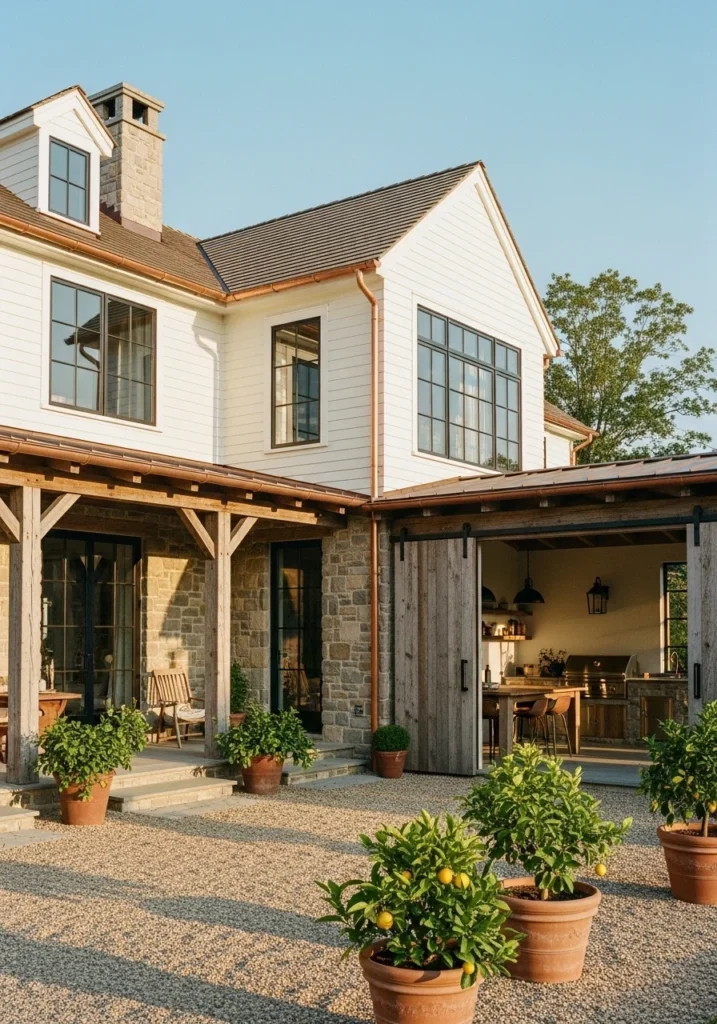
Blend colonial symmetry with farmhouse practicality using painted clapboard over stone base, reclaimed timber porch beams, and oversized steel windows.
Add barn door opening to outdoor kitchen and gravel courtyard with potted citrus for casual elegance that works for both formal and relaxed entertaining.
This approach appeals to people who want colonial sophistication with more relaxed, family-friendly functionality.
Formal Courtyard with Private Forecourt
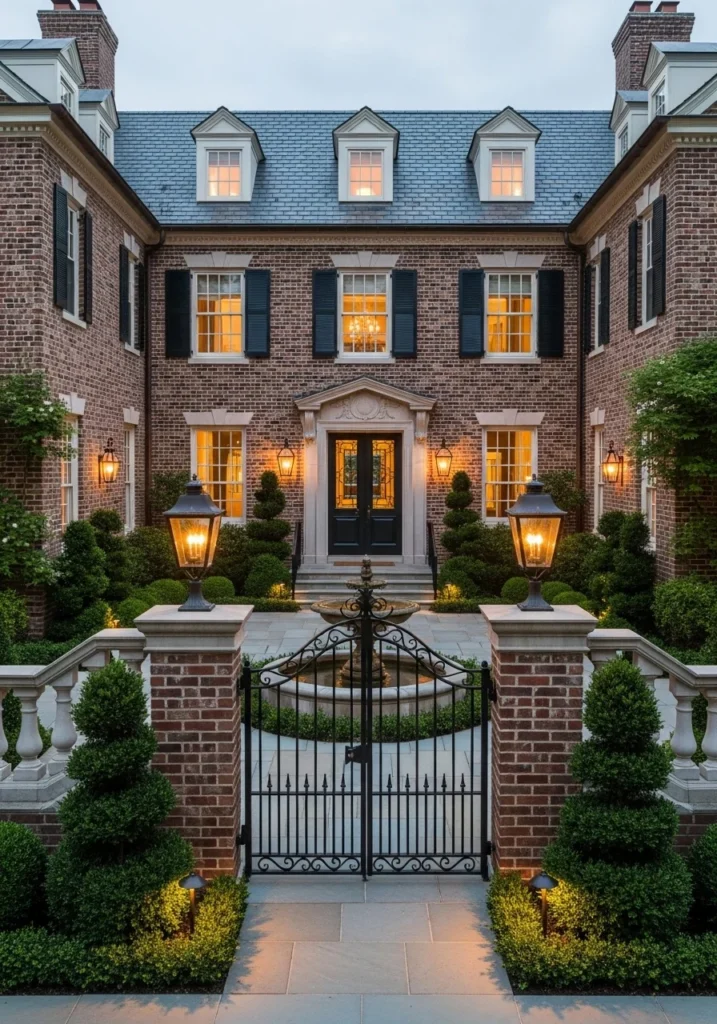
Design twin symmetrical wings creating private entry courtyard with wrought-iron gates and central fountain for European-inspired luxury.
Include limestone steps, topiary plantings, and period-appropriate lighting. The courtyard provides privacy while the fountain adds soothing sound and movement.
Works well on larger lots where creating private arrival experience is desired.
Sustainable Colonial with Integrated Technology
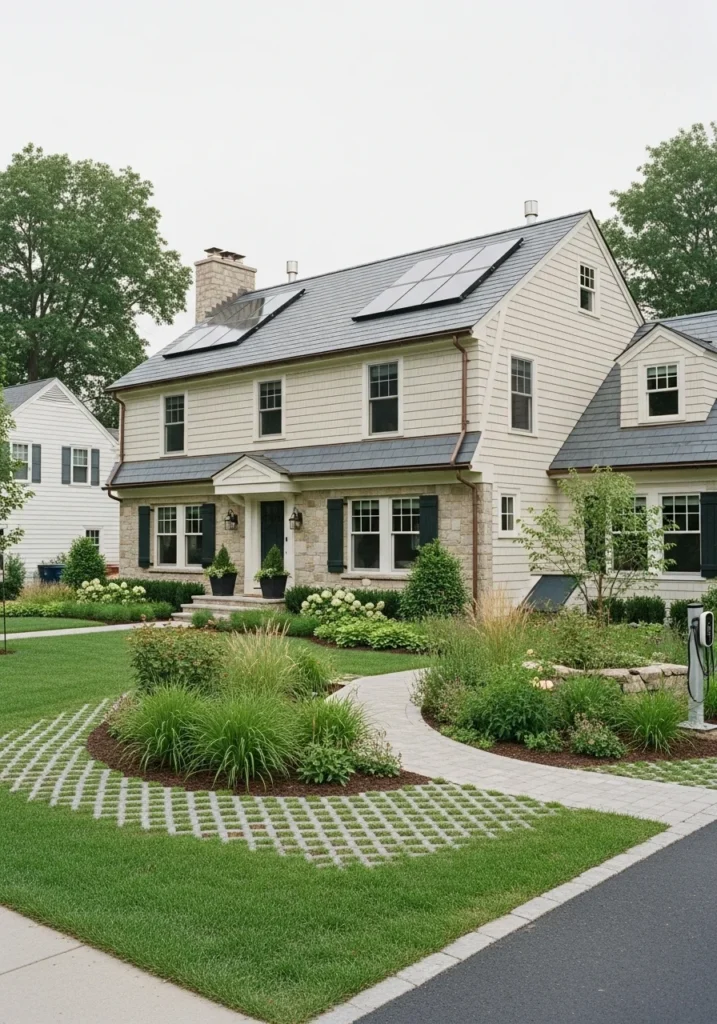
Update traditional gabled colonial with solar slate tiles, hidden systems, and front rain garden that handles stormwater while looking like intentional landscape feature.
Use traditional materials like cream clapboard and natural stone while incorporating EV charging and native plantings that require less maintenance.
Perfect for people who want colonial charm but also prioritize environmental responsibility and modern convenience.
Dramatic Black and White with Floating Porch
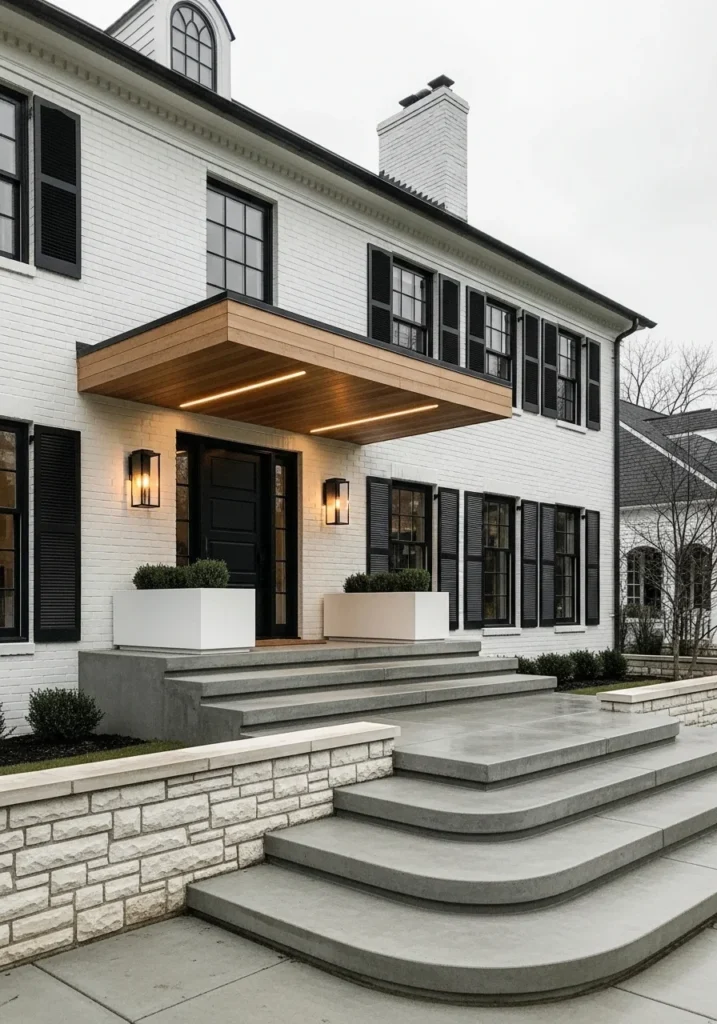
Create bold contrast with white brick facade, black shutters, and cantilevered timber porch roof that appears to float above the entry.
Add sculptural concrete steps and minimalist plantings that emphasize clean geometry. The floating porch provides weather protection while making dramatic architectural statement.
This approach works for people who want colonial bones with contemporary drama and bold design choices.
Glass Conservatory Integration
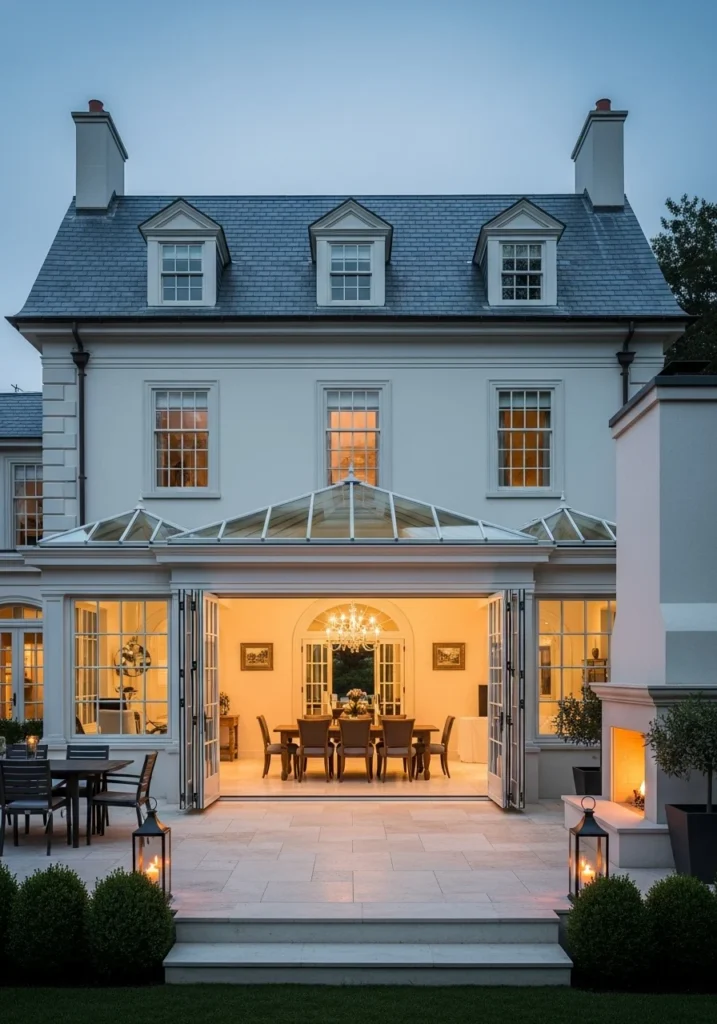
Attach traditional symmetrical colonial to glass conservatory that opens onto formal terrace with outdoor fireplace for seamless indoor-outdoor entertaining.
Keep main house traditional with sash windows while the conservatory provides transition space between formal interior and outdoor living areas.
Great for people who entertain frequently and want space that works year-round in various weather conditions.
Urban Townhouse with Rooftop Access

Adapt colonial principles for narrow urban lots with three-story design, warm brick, and modern rear extension leading to private rooftop terrace.
Include traditional front stoop with period lanterns while the rear addition provides contemporary space and outdoor access despite urban constraints.
Perfect for city living where outdoor space is limited but colonial character is desired.
Rustic Stone with Copper Accents
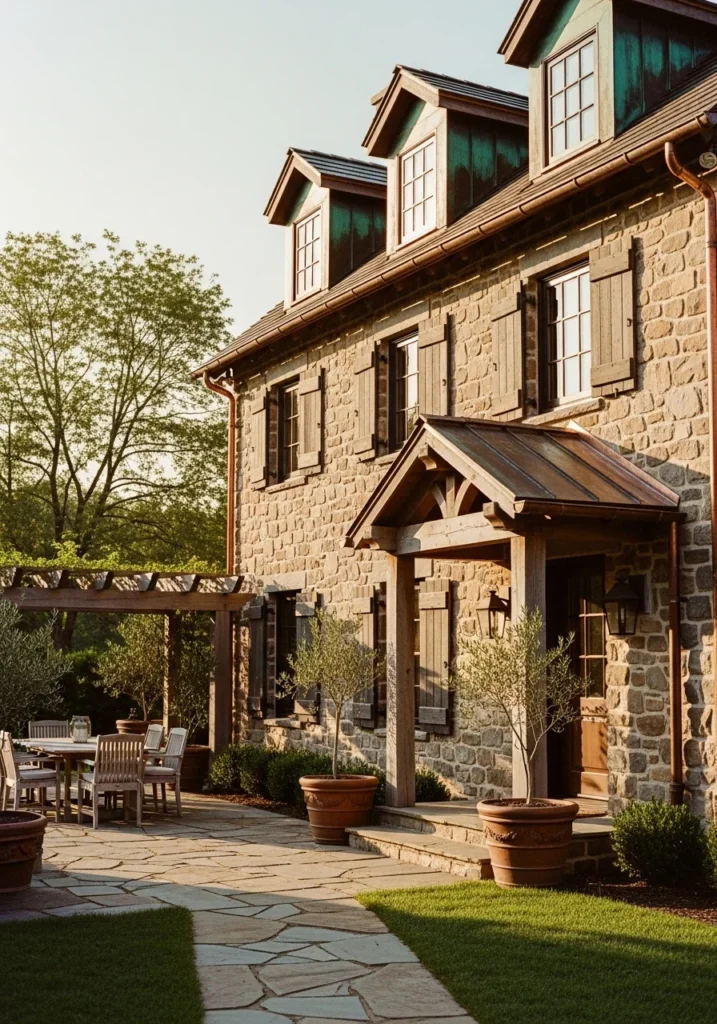
Build in hand-cut fieldstone with wood shutters and copper elements that develop beautiful patina over time for authentic material richness.
Add flagstone paths, timber porch, and Mediterranean-inspired plantings with terracotta containers for warmth and character.
Appeals to people who want colonial substance with more relaxed, organic material palette rather than formal painted surfaces.
Contemporary Colonial with Floating Elements

Update colonial with pale stucco facade and floating timber porch over reflecting water trough for modern architectural drama within classical proportions.
Use slim black window frames and minimalist boxwood plantings for formal composition that feels both traditional and cutting-edge.
Perfect for people who want colonial elegance with contemporary architectural features that make the house feel unique and current.
Making Colonial Work for Your Life
The best colonial exteriors don’t try to recreate the past exactly—they take the principles that made colonial architecture timeless and adapt them for contemporary living.
Think about what you actually need from your house exterior: weather protection, outdoor living space, privacy, curb appeal, maintenance requirements. Then choose colonial-inspired solutions that serve those real needs while creating the aesthetic you love.
Colonial design has survived centuries because it’s based on human-scale proportions and quality materials that create genuinely comfortable, beautiful homes. When you focus on those fundamentals rather than copying historical details exactly, you get houses that feel both rooted in tradition and perfectly suited to modern life.

